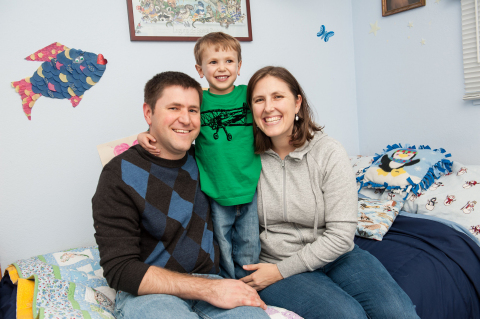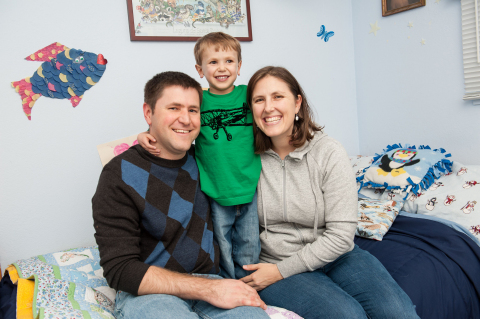STANFORD, Calif.--(BUSINESS WIRE)--With 19 heart transplants, 2013 was the busiest year ever for the Children’s Heart Center at Lucile Packard Children’s Hospital Stanford, home to the only pediatric heart transplant program in Northern California. This success offers hope for those still waiting for this lifesaving gift.
One such patient is 4-year-old Aiden Hansen, who doesn’t let the combination of his rare, hypoplastic left heart syndrome and heterotaxy syndrome stop him from loving planes, cars and going to music classes. When he was only 3 days old, his doctors in Santa Rosa suspected something was very wrong. A series of echocardiograms and ultrasounds revealed that his heart had a missing ventricle, his liver and stomach were in the wrong place and he had multiple spleens. Parents Jesse and Shifra then brought Aiden to Lucile Packard Children’s Hospital Stanford.
Aiden had his first open-heart surgery when he was 10 days old under the hands of Mohan Reddy, MD, who is also a professor of cardiothoracic surgery and of pediatrics at the Stanford School of Medicine. Over the years, Aiden has had three open-heart surgeries as well as having a pacemaker implanted. Now Aiden and his family are eagerly waiting for a donor heart, and are grateful to be cared for by a program ranked in the nation’s Top 10 by U.S. News & World Report.
Providing hope for kids like Aiden are the 19 heart transplant patients from 2013. Athlete and sports nut Gavin Jack of Soquel, Calif., is in that club. Last October, the 18-year-old received a donor heart in a transplant surgery led by Katsuhide Maeda, MD, who is also a clinical assistant professor of cardiothoracic surgery at the medical school. “Gavin’s recovery since his transplant has been amazing,” said his mom, Michele, who expressed her extraordinary gratitude for the gift of organ donation.
Patient families know that it takes a village to provide world-class, nurturing care before, during and after a heart transplant. “We have extraordinary experience,” said David Rosenthal, MD, director of the hospital’s pediatric heart failure program and professor of pediatric cardiology at the Stanford School of Medicine. Rosenthal noted that the hospital’s busiest year prior was 2009, with 17 transplants.
“Teams across the hospital understand the difficulties these patients and families are facing,” he said.
The legacy of heart transplant at Stanford can be traced to 1968, when the first adult heart transplant in the United States was performed at Stanford by pioneer Norman Shumway, MD. Shumway was also a leader in the development of heart transplants for children and young adults. Throughout the decades, Stanford Medicine and Lucile Packard Children’s Hospital Stanford have pioneered the research and development of tools, medicines, ventricular-assist devices and anti-rejection protocols to help ensure heart transplant success.
Success rates for pediatric heart transplant have risen over time. In general, there is a 90 percent survival rate for transplanted patients at the one-year point. At three years, there is an 80 to 85 percent survival rate. At five years, 75 to 80 percent. After that, survival rates become increasingly hard to trace because the treatments and protocols are constantly evolving.
“The heart failure and transplant teams in the Children’s Heart Center are grateful to have helped 19 children with lifesaving heart transplants in 2013,” said Stephen Roth, MD, MPH, director of the Center and professor of pediatric cardiology at the School of Medicine. “As our program expands, we are treating more children from California and the western United States with severe heart failure each year.”
“Transplantation is a critical component of the advanced treatment options we offer, and we’re very happy to have the expertise needed to ensure the best possible transplant outcomes,” Rosenthal said.
About Lucile Packard Children’s Hospital Stanford
Lucile Packard Children’s Hospital Stanford is an internationally recognized 311-bed hospital and leading regional medical network providing a full complement of services for the health of children and expectant mothers. Together, our world-class Stanford Medicine doctors, nurses and staff deliver innovative, nurturing care and extraordinary outcomes in every pediatric and obstetric specialty. Packard Children’s is annually ranked as one of the nation’s finest by U.S. News & World Report and the only Northern California children’s hospital with specialty programs ranked in the U.S. News Top 10. Learn more about our full range of preeminent programs at lpch.org and the Packard Children’s Health Alliance at PCHA.org. Like us on Facebook, watch us on YouTube and follow us on Twitter.




